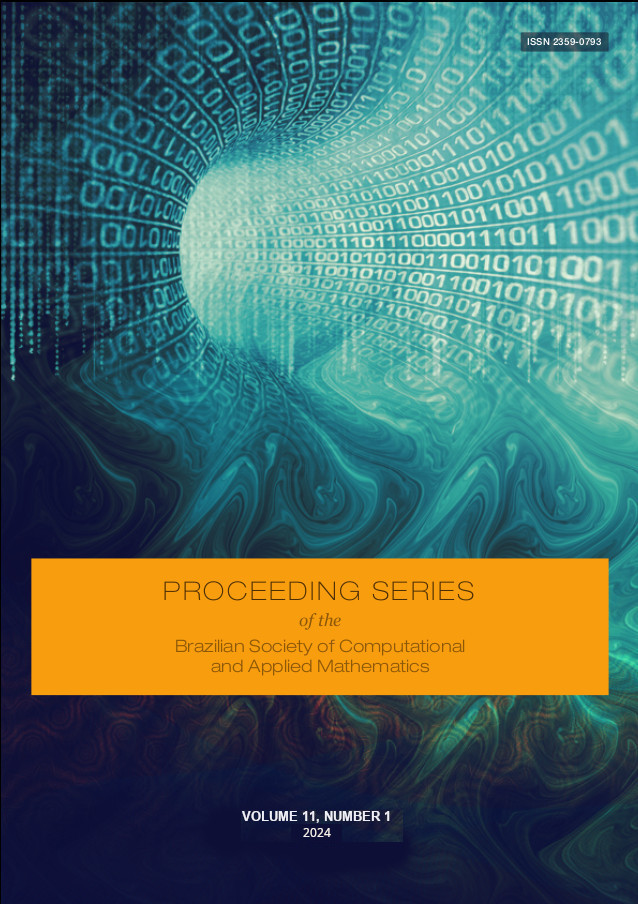A mixed finite element method for a µ(I)-rheology model of granular materials
DOI:
https://doi.org/10.5540/03.2025.011.01.0333Palabras clave:
granular flows, nonlinear viscosity, twofold saddle point, mixed finite elements, fixed-point theory, a priori error analysisResumen
We propose and analyze new mixed finite element methods for a regularized µ(I)-rheology model of granular flows with an equivalent viscosity depending nonlinearly on the pressure and on the Euclidean norm of the symmetric part of the velocity gradient. To this end, and besides the velocity, the pressure and the aforementioned strain rate, we introduce a modified stress tensor that includes the convective term, and the skew-symmetric vorticity, as auxiliary tensor unknowns, thus yielding a mixed variational formulation within a Banach spaces framework. Then, the pressure is obtained through an iterative postprocess suggested by the incompressibility condition of the fluid, which allows us to express this unknown in terms of the aforementioned stress and the velocity. A fixed-point strategy combined with a solvability result for a class of nonlinear twofold saddle point operator equations in Banach spaces, are employed to show, along with the classical Banach fixed-point theorem, the well-posedness of the continuous and discrete formulations. Optimal a priori error estimates are derived and associated rates of convergence are established. Finally, numerical results confirming the latter and illustrating the good performance of the method, are reported.
Descargas
Citas
M. Alnæs, J. Blechta, J. Hake, A. Johansson, B. Kehlet, A. Logg, C. Richardson, J. Ring, M. E. Rognes, and G. N. Wells. “The FEniCS project version 1.5”. In: Archive of numerical software 3.100 (2015).
D. Arnold, R. Falk, and R. Winther. “Mixed finite element methods for linear elasticity with weakly imposed symmetry”. In: Mathematics of Computation 76.260 (2007), pp. 1699–1723.
G. A. Benavides, S. Caucao, G. N. Gatica, and A. A. Hopper. “A Banach spaces-based analysis of a new mixed-primal finite element method for a coupled flow-transport problem”. In: Computer Methods in Applied Mechanics and Engineering 371 (2020), p. 113285.
S. Caucao, G. N. Gatica, S. R. Medrado, and Y. D. Sobral. “Nonlinear twofold saddle point-based mixed finite element methods for a regularized (I)-rheology model of granular materials”. In: Journal of Computational Physics 520 (2025), p. 113462.
S. Caucao, R. Oyarzúa, and S. Villa-Fuentes. “A new mixed-FEM for steady-state natural convection models allowing conservation of momentum and thermal energy.” In: Calcolo 57.4 (2020).
S. Caucao and I. Yotov. “A Banach space mixed formulation for the unsteady Brinkman–Forchheimer equations”. In: IMA Journal of Numerical Analysis 41.4 (2021), pp. 2708–2743.
E. Colmenares, G. N. Gatica, and J. C. Rojas. “A Banach spaces-based mixed-primal finite element method for the coupling of Brinkman flow and nonlinear transport”. In: Calcolo 59.4 (2022), p. 51.
L. Jing, C. Y. Kwok, Y. F. Leung, and Y. D. Sobral. “Characterization of base roughness for granular chute flows”. In: Physical Review E 94.5 (2016), p. 052901.
L. Jing, J. M. Ottino, P. B. Umbanhowar, and R. M. Lueptow. “Drag force in granular shear flows: regimes, scaling laws and implications for segregation”. In: Journal of Fluid Mechanics 948 (2022), A24.
P. Jop, Y. Forterre, and O. Pouliquen. “A constitutive law for dense granular flows”. In: Nature 441.7094 (2006), pp. 727–730.
S. B. Savage and K. Hutter. “The motion of a finite mass of granular material down a rough incline”. In: Journal of fluid mechanics 199 (1989), pp. 177–215.

